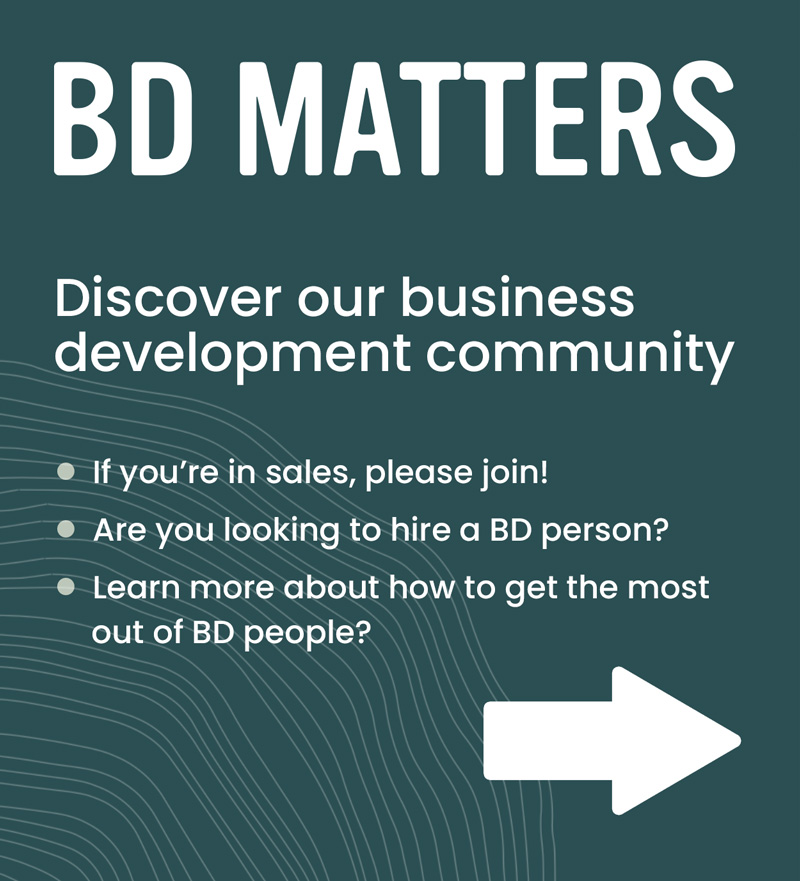
13 forms of proof & credibility to attract new business
November 29, 2022
You’ll struggle massively to get people to believe you if you don’t have proof and credibility, and you don’t need a psychology degree to know that if people don’t believe you, they won’t buy from you.
If you’re not turning at least part of your attention to proving your agency is credible, you’re likely to be missing out on sales. If you are diligent about gathering proof, you’ll get more ideas from the list below.
1) Reviews and Testimonials
It’s the most obvious but as new biz experts, you’d be surprised how many times we come across agency owners who don’t have at least one of these in their repertoire.
We’ve heard many reasons like “I felt uncomfortable asking,” “I wasn’t sure when to ask,” and “I sent an email but never followed up.” We can write a whole blog post on how and when to reach out but for now, it’s important to know why you should ask.
And the answer is simple: People trust other people more than a brand or a business.
So how can you use reviews and testimonials? Start by putting them up on your website and follow these three tips:
- Have your testimonials sit on their own webpage and include it in your navigation menu. This allows your prospects to easily find it and it’ll help the page show up in search engine results.
- Put your most noteworthy reviews and testimonials on your homepage. This is the most visited page on your website, so it’ll get more eyes on it.
- Place a CTA button under your testimonials. You’re more likely to convert users here.
You can get creative with these too, why not ask a happy client if you could video their testimonial?
And if you don’t have the time or resources for something fancy, keep it simple. We’re inspired by the testimonial page from The Agency Creative.
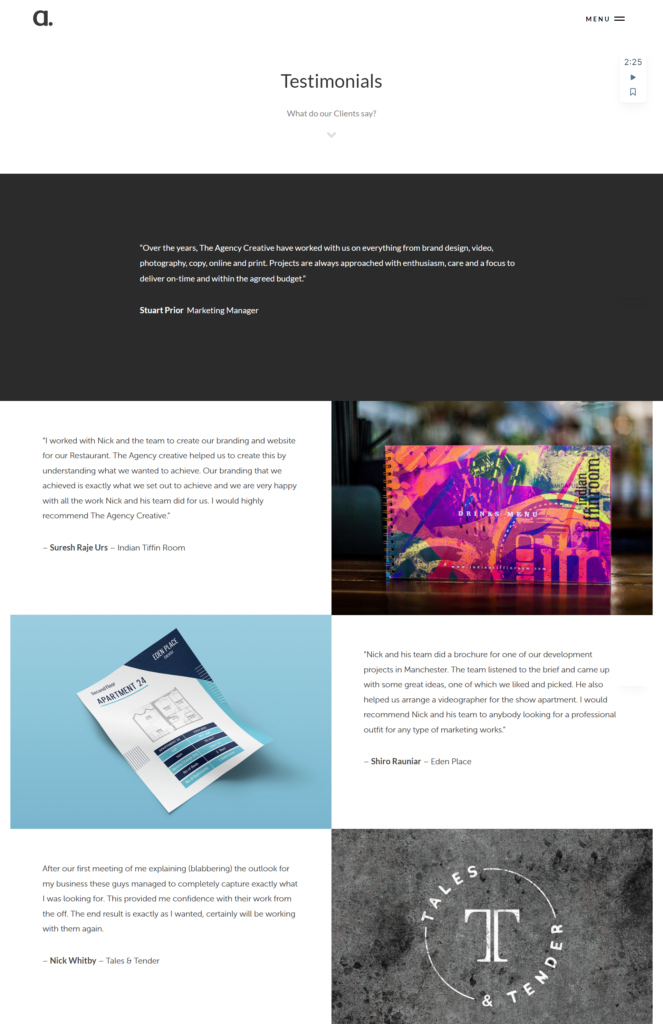
2) Case Studies
These can be highly effective but not if you’re sending your prospect pages to read. While case studies should offer a detailed look at a real-life story of someone who’s used your agency’s offerings, it still needs to be kept short.
Another mistake we see agency owners make is that they send over their case studies without tailoring or mirroring them to their prospect’s sector and project requirements.
For example, if you’re a web design agency and your prospect is from a skincare brand wanting an entire overhaul, make sure the first case study they see is from the time you worked with Nivea, not the single landing page you did for EasyJet.
If your case studies sit on your website, categorise them by thinking about your buyer persona. This helps your prospects to navigate to the most relevant one. From a buyers perspective, they’re often interested in a) the challenge solved b) the type of work and services c) impact.
That’s not to say you shouldn’t include projects if it was one of your agency’s best works, but be mindful that people are time-poor. Some will scan and some won’t go past the first page.
Each case study should do enough to gain intrigue but ideally, they should be designed to get you in a room to present a more in-depth case study. That’s where you can go into detail and win over your prospects.
Note for points 1 & 2:
When reaching out to your clients for a review, testimonial and/or case study, ask them to include the emotional impact (along with project details and tangible results). The emotional aspect is significantly effective but it usually flies under the radar.
Another non-conventional idea is to write up the case studies that didn’t go to plan! It’s a bold move but there’s nothing more trusting than an agency that is humble and honest about what went wrong but it also allows you to talk about what you did to improve things.
At the very least agencies should be demonstrating the process and the relationship between them and the clients – it’s not just about the work.
If you can’t do the above right now, the least you should be doing is name-dropping the brands you’ve worked with and are working with.
3) User-generated content (UGC)
UGC is about transparency. It is created by individuals rather than the brands themselves, so reviews and testimonials can fall into it but there’s more.
If you’ve ever run an agency event, and an attendee took a picture, uploaded it on their social media account, and tagged your agency, it’s UGC.
Many agency owners aren’t using UGC to its full advantage and that’s because they’re not really sure how it applies to the agency world.
You can encourage and incentivise your clients or existing partnerships to talk about your services.
If you run events, workshops or webinars, prompt attendees to share the details with their network. It’ll demonstrate that there are other businesses and individuals who trust your agency and find value in what you do.
You can also lean on your employees. Encourage your employees to talk about the culture in your agency, what they like about working for you, career milestones they’ve had etc. You could set up an employee advocate programme where there’s an incentive for employees to post company content regularly (just make sure there are some basic guidelines in place!). This is also great for attracting new talent.
4) Referrals
Recommendations are often the most credible form of advertising and there’s a lot you can do to increase them.
Nurture your relationships with past and existing clients. Some efforts include treating them to lunch and/or congratulating them on their successes.
Offer a referral reward program and create an incentive that’s attractive and of value. For example, for existing clients, you could apply a discount on their next month of service.
We love how Maddison Creative (a design agency in Newcastle-upon-Tyne) have a referral scheme that is simple enough to be understood by clients and sustainable for them to offer it for the long term.
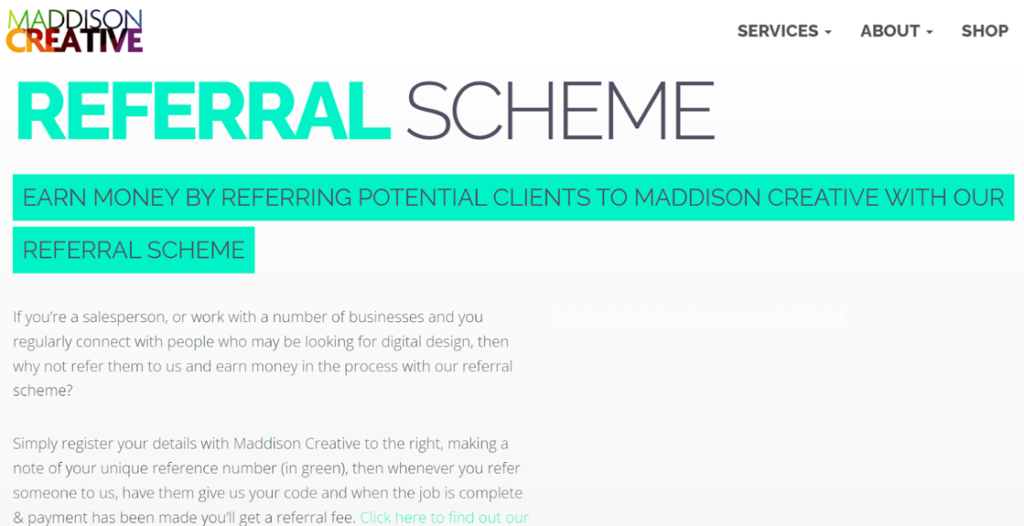
Another great way to create a steady stream of new referrals is to partner with an agency with the same client profile. For example, an offline media agency could do well by partnering with a creative design agency. Note, it’s important to be very specific with what you’re looking for as a perfect prospect profile. People find it very hard to offer referrals when the ask is a bit vague.
Referrals can from other ways too including tech/supplier partners (particularly for dig agencies), community groups and trade bodies.
5) Micro-influencers
Seeing as not all of us are in a position to reach out to a Mark Ritson or a Gary Vee, we won’t entertain high-profile influencer endorsements.
Micro-influencers on the other hand are completely achievable. By micro-influencers, we mean thought leaders who have a decent amount of following and influencing power, at a smaller scale than the big players in the field.
This could be other agency owners, those with large profiles, trade bodies, marketing directors etc. They may not even see themselves as a thought leader but if what they’re saying aligns with your values, and they’re getting decent engagement for it, you can class them as one.
A micro-influencer’s smaller following can be even more powerful than the most renowned names. These types of influencers often have stronger relationships with their followers, built on expertise and trust. And if you can get them on board, you’ll gain trust by association.
One way to engage with them is to have your agency host a webinar that would attract potential prospects and have a micro-influencer as a speaker. They are likely to have lower costs (or you could eliminate costs altogether by providing another attractive incentive) and be more available than a macro influencer.
You may think, “why would they want to speak at an event?” For many reasons, maybe they want to give back, they need some variation from their familiar day-to-day, they want an incentive, they want to boast about it to colleagues, they want to raise their own, or their company’s profile, they want to build their network, they’re job hunting and it looks impressive on their CV or simply, they have an ego they need to stroke.
You may have even been mentored by someone in your early days who is a micro-influencer today or has been in the game a lot longer than you have. Highlight them and talk about how they played a hand in your success.
6) Be a thought leader
Don’t underestimate the power of your own voice. You could build a personal brand (personal LinkedIn accounts work well) and resist the sales push.
It can be scary but don’t let fear stop you. Figure out what your barriers are e.g. imposter syndrome, introversion, lack of confidence etc. and address them with the help that’s out there from mentors to counsellors, to professional courses.
If you’re providing value and people are engaging with you, they’ll naturally check out more of your stuff such as your agency’s offerings and they’ll follow you so you’re front of mind.
Ways to do this include sharing knowledge on social platforms (check out LinkedIn’s Publishing Platform which allows members of a LinkedIn Page to write, edit, and share articles on LinkedIn), writing guest blogs, talking on podcasts and speaking at events.
Publishing regular and valuable thought leadership will make you a trusted resource and therefore more credible. But don’t say yes to everything, the key is being where your prospects are looking for information.
7) Media & Press Coverage
If you’re creating your own thought leadership, why not reach out to niche magazines to pitch an article that will be valuable to their audience?
And don’t forget about agency wins including new business. If you’ve got something to shout about that would be of interest to the press, send it across to the relevant journalist and cc’ the editor.
We hear agency owners say that they know the value PR can bring, but they’re not sure it’s attainable for them or they don’t know how to go about it.
You can start by building up a distribution list of journalists that you can expand over time. There are also freelancers out there who can help you with press releases or even provide you with templates so you can do it in-house.
The below example showcases how Proflic North, a regional newspaper, featured an article about LOVE creative (a Manchester-based design agency). LOVE helped the world-famous Kentucky bourbon distillery, Jim Beam to overhaul and rebrand its 400-acre distillery, brand and visitor experience.

Remember to highlight any coverage you receive on your website.
8) Social shares
In the age of social media, if you have too few social shares or followers, you run the risk of negatively impacting your agency.
Some prospects will look at how well-maintained and how engaging your social channels are to get an idea of the attention to detail, quality and strength of the community you’ve built for yourself.
Having a buzzing social community won’t happen overnight, but you do need to start now and have a growth strategy for your agency’s social channels. At the least, you should be churning out regular content.
If you’re spread too thinly around too many channels, consider specialising in one (look at the data from sources such as Google Analytics to determine where you’re getting the most engagement and web traffic).
Yes, it might sound limiting, but it’s best to excel on one channel than to have diminishing returns across several.
9) Videos
Any marketer would know how effective video marketing can be in not only building trust and credibility but converting. Videos can have more power than a prospect reading text on a screen.
Your prospects are more likely to trust an agency that they’ve heard of or seen and the memorability of a video is more likely to put you front of mind.
UGC videos are great but if you want more control over your messaging, why not create your own “behind-the-scenes” video? This will allow your prospects to see your talent and the expertise involved.
Make, a design agency has used their “hard-at-work” video on their homepage which is far more effective than a static background and instantly makes the folk there seem more personable.
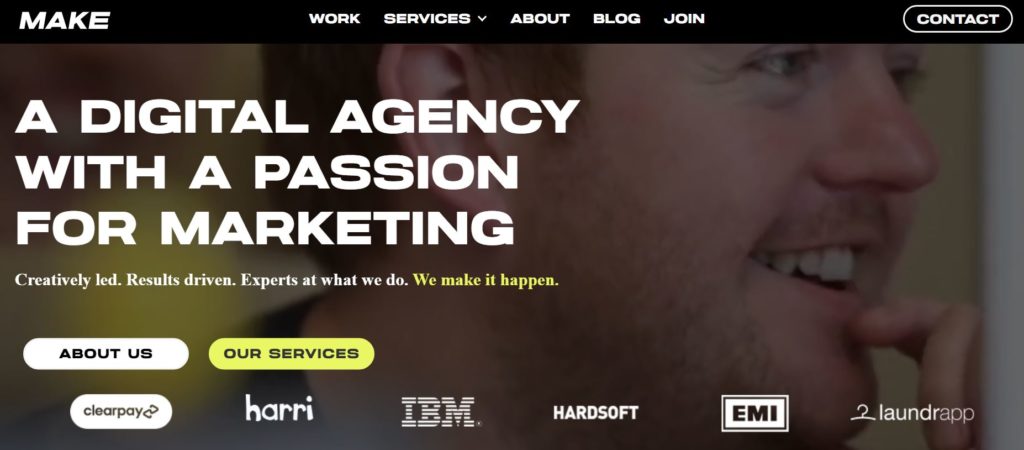
10) Stat-dropping
Just like name-dropping, stat-dropping is something all agency owners should do. We’re not talking about exposing anything too precious or against GDPR rules, but we mean stats and numbers that you could easily obtain and reveal for proof and credibility.
For example, been in the agency world for 10+ years? That’s impressive and instantly implies to a prospect that they’re in good hands.
Has your agency helped a handful of brands? Include it in a headline on your website. For example, if you’re a packaging agency specialising in cosmetics, you could say “50+ beauty brands now have beautiful and functional packaging to match their products”. List the brands too!
Is word-of-mouth your main way of getting new business? State how much. For example: “60% of our clients over the past 2 years came from direct recommendations.” A prospect will see that you must be a great agency if people are referring you to their network.
Gravitas, a “more than a marketing agency” do this really well by adding 3 strong stats side-by-side, just under the main banner on their “About Us” page.
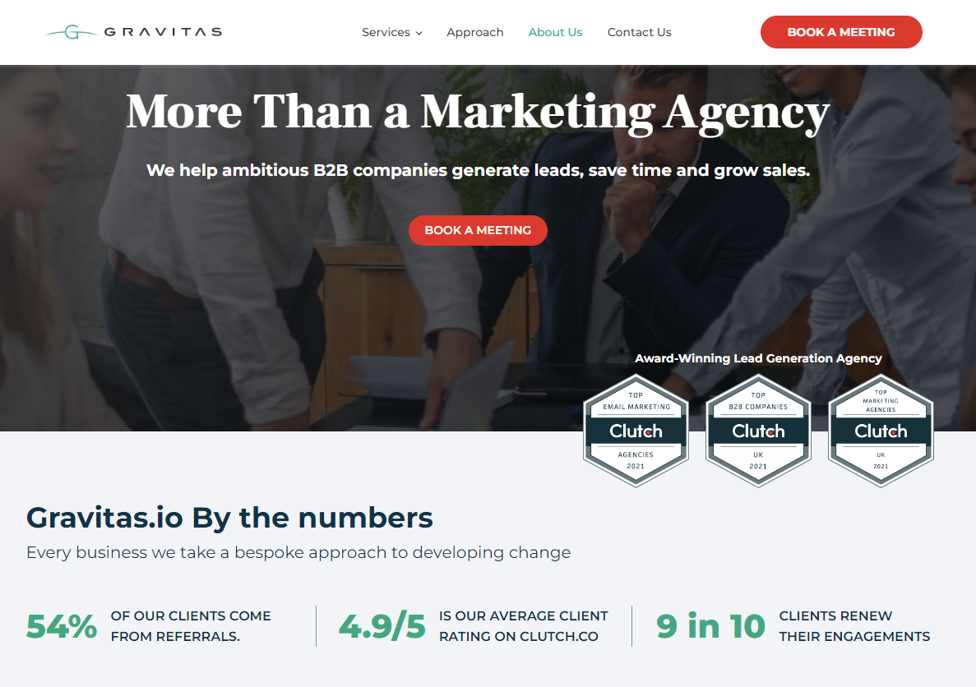
Have you got a decent (or impressive) number of subscribers to your agency newsletter? Follow the path of IDEADECO and reveal how many subscribers you have already. People like to follow the actions of others so this can be a great way to increase your database.
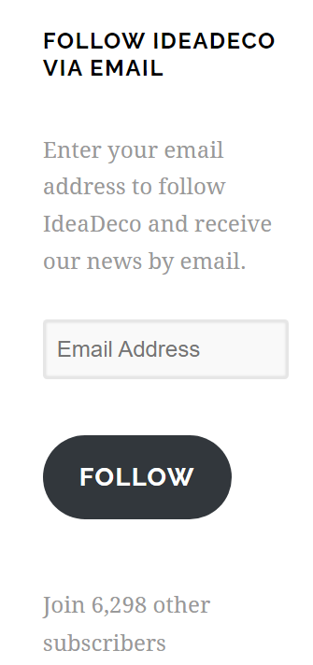
11) Awards & Accreditations
Awards can instantly put a sceptical mind at ease. If you’ve won any recent awards for your work, add them to your site. This will show your prospects that you’re not only good at what you do but you’re also acknowledged and valued for it.
This also goes for any trust badges, partnerships or affiliates you have. They all serve as a vote of confidence for potential clients and you never know, it could be the deciding factor for choosing your agency over another agency that has nothing to showcase.
It’s not something we see often, but we like how this digital agency called HOP has included its awards on its navigation menu as well as having a dedicated webpage for it. You could also add your awards to your email signature.
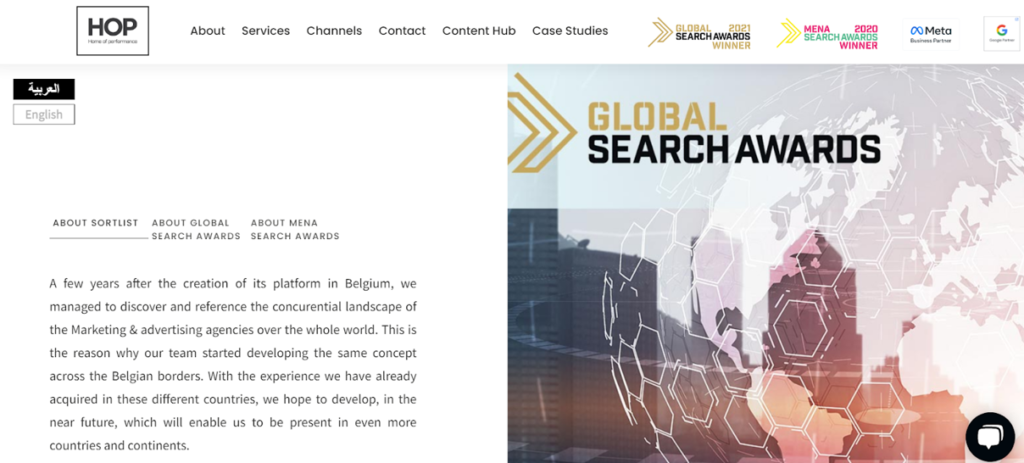
12) Honesty & Integrity
People trust people who are open, honest and transparent. As an agency, there are many things you can, and should, be transparent about.
- Why do you do what you do? Other than making money of course. What problem do you want to solve for your prospects or society?
- How are you different from your competitors? It’s unlikely you’re the only agency that your prospect is talking to, so explain what makes you unique. You can take inspiration from your agency’s experiences, losses, victories and origin story.
- If you have an agency mission, vision, and/or values, are they coming through consistently in your comms? Are you showcasing how you’re living up to them?
- A real common worry among prospects is whether picking your agency will get them the results they want and need. Address their fears and concerns openly.
- In the scenario that you and your prospect feel you’re not a right match for one another, leave by telling your prospect how much you’ve enjoyed the conversation regardless. If you can, continue to build credibility by suggesting other companies that might be able to help them. They may return the favour by recommending your agency to someone they know.
Don’t worry about being vulnerable and revealing things about yourself as that helps other people lower their barriers.
13) People
It ultimately comes down to your people, which is why it’s crucial to hire the right talent and have a healthy culture in place.
Hire people who share your values. If one of your values is to not be overly pushy, don’t hire a salesperson who’s going to relentlessly chase prospects with 10 emails a day.
As an agency leader, you need to create a culture of openness and being able to speak your mind to build trust and credibility within your team.
People buy into people so rather than talking all about your agency, make sure your prospects can see who you are as individuals and as a team.
To conclude
While you believe in your agency’s offerings, you can’t expect your prospect to, which is why you need multiple forms of proof to build up your credibility. People buy into people, and many of your prospects will be wary of working with an agency so you need to find a way of building trust.
If you need help getting into the groove of it, book a call.
